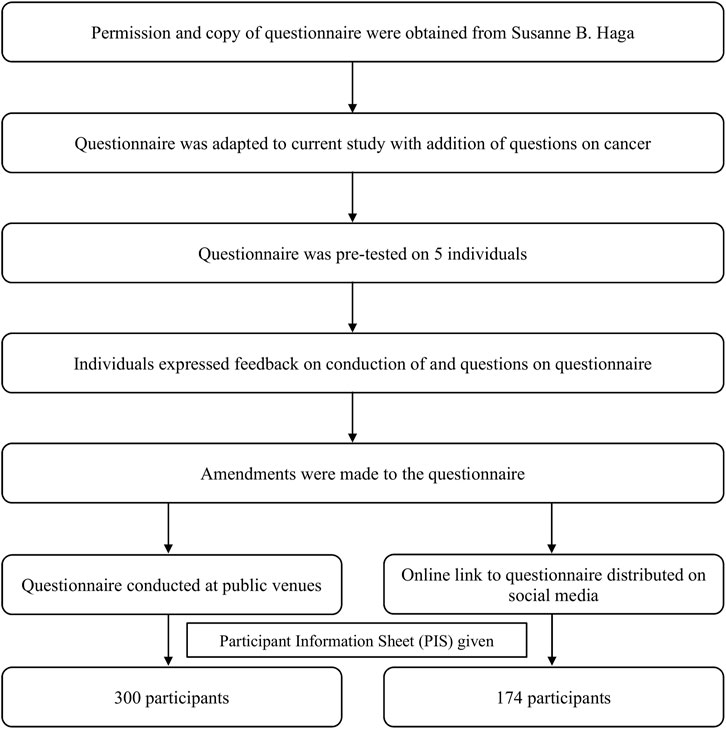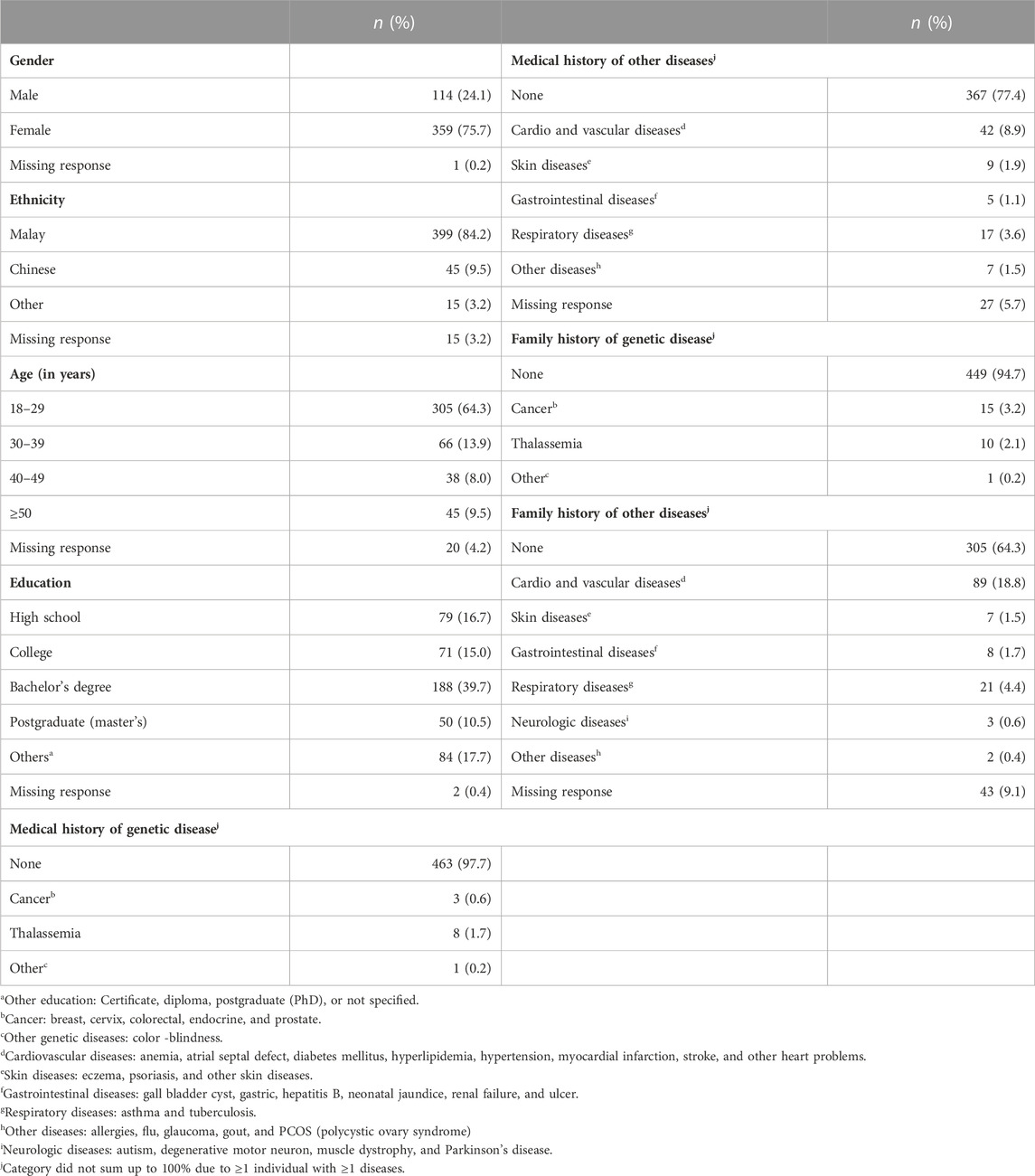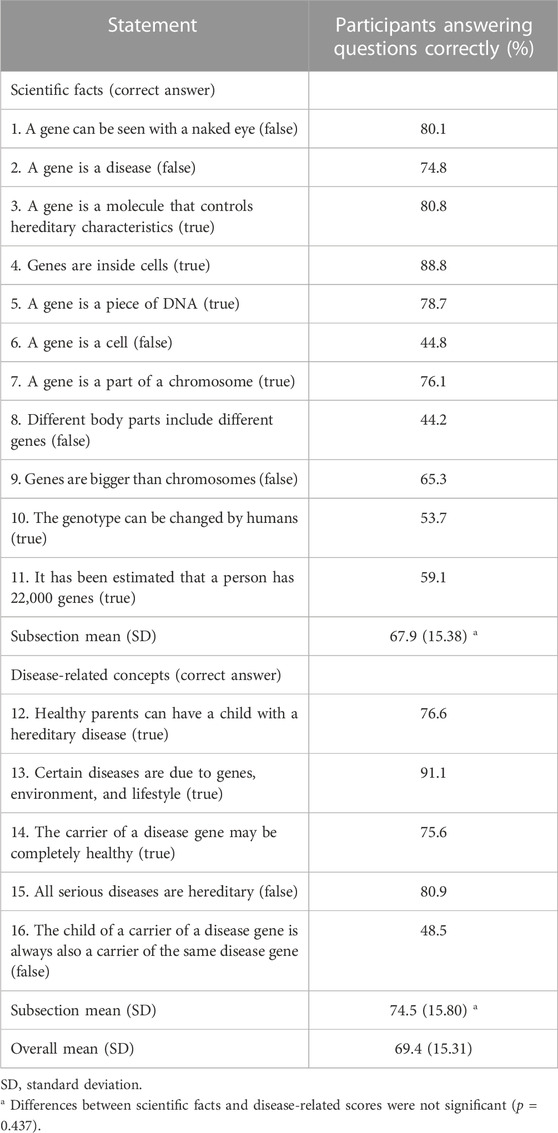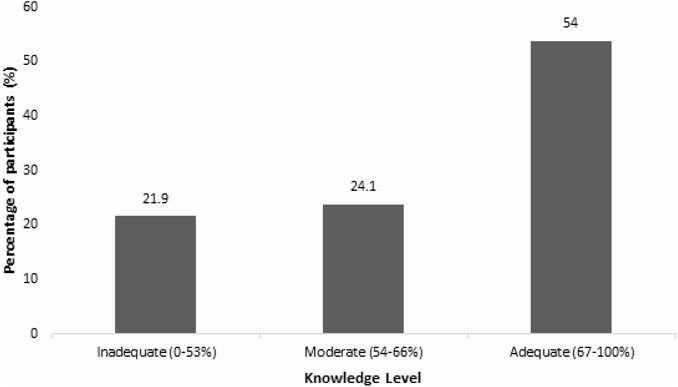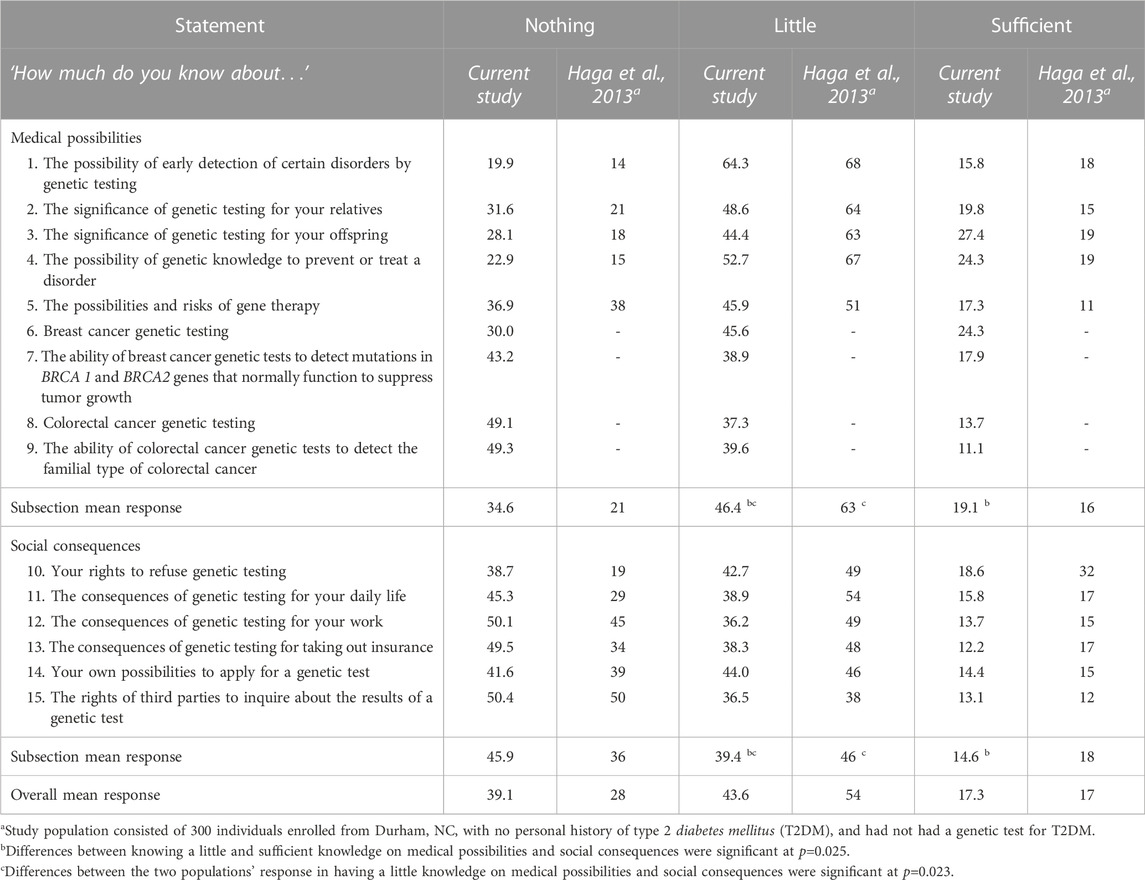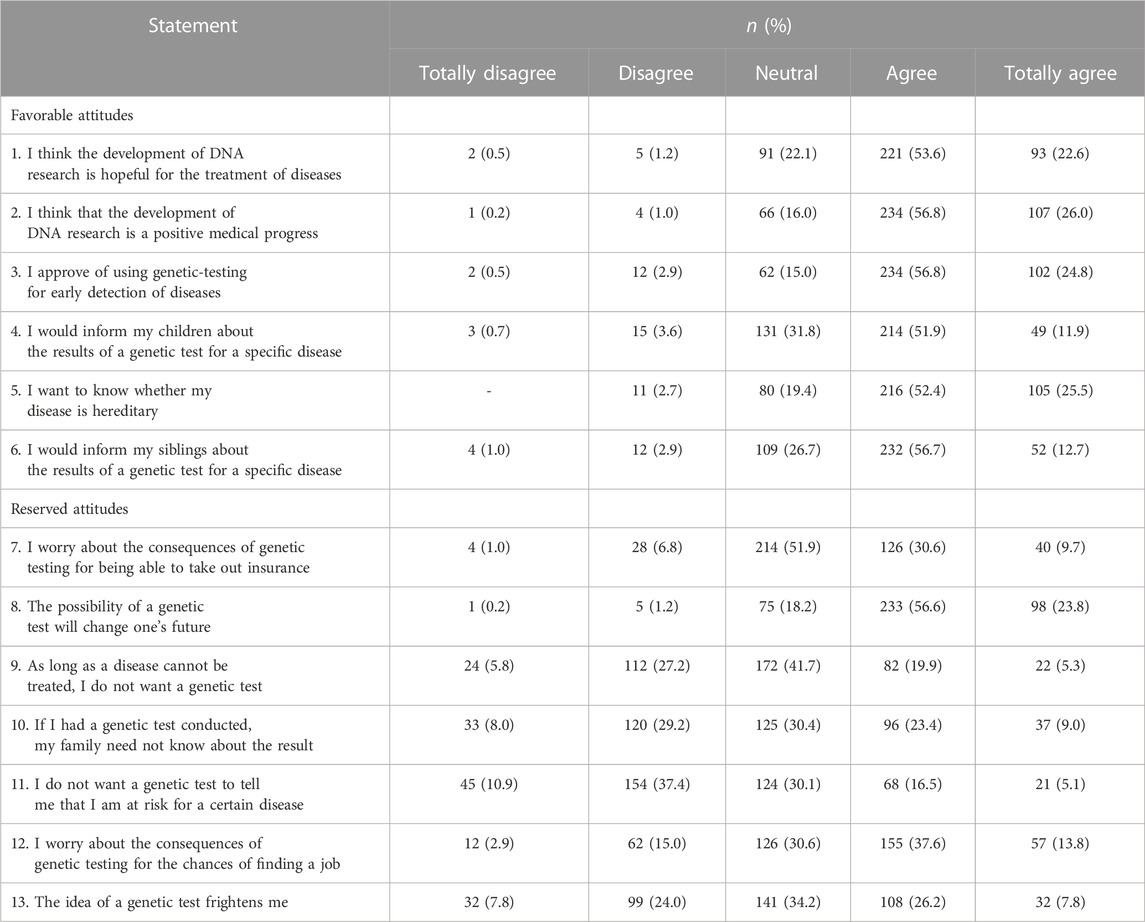- 1Raja Isteri Pengiran Anak Saleha Hospital, Bandar SeriBegawan, Brunei
- 2Halalan Thayyiban Research Centre, Universiti Islam Sultan Sharif Ali, Tutong, Brunei
- 3Pengiran Anak Puteri Rashidah Sa’adatul Bolkiah (PAPRSB) Institute of Health Sciences, Universiti Brunei Darussalam, Gadong, Brunei
The world has been experiencing encouraging research in genetics, but current public knowledge, awareness, and perception of this area remain unknown for Brunei Darussalam. This study aimed to investigate the Brunei population’s genetics and genetic testing literacy, and their attitude toward them. A cross-sectional study was carried out targeting public population in Brunei Darussalam. Questionnaires on knowledge and attitudes were randomly distributed in frequented venues in the Brunei–Muara district and uploaded online for distribution through social media. Responses were scored and analyzed using appropriate statistical methods. Overall, the sample population (n = 474) comprised 75.7% female, 64.3% aged 18–29 years old, 39.7% with a bachelor’s degree, and 2.3% and 5.3% with a personal history and family history of genetic disease(s), respectively. Younger participants scored higher for disease-related questions and showed more concern on the impact of testing on employment but were more fearful of testing. Higher educational qualifications were associated with a higher knowledge score, a more optimistic view on DNA research, and less reluctance to take a genetic test for an untreatable disease. Participants with a personal history of genetic disease(s) were more knowledgeable and displayed higher curiosity. Participants with a family history of genetic disease(s) were also more knowledgeable and would want testing even for an untreatable disease. Significantly less was known about the social consequences of testing compared to the medical possibilities. Investigating the knowledge and attitudes of the population is vital preceding efforts toward national adaptation of genetic testing, keeping in mind the various obstacles and issues surrounding the subject.
1 Introduction
The world of genetics is constantly engaged in the discovery of the latest genes, propelling endless promises upon application of this information. Accompanied by the rising advancements in technology and analysis (Goodwin et al., 2016), research on genetics leads to critical understanding and efforts such as ascertaining risk factors (Haga et al., 2013) and imposing prevention and treatment of the diseases they cause. The expanding possibilities of this field have led to the growing interest around genetic testing. An example can be seen in hereditary breast cancer whereby the demand for genetic testing to predict hereditary risks is increasing since the discovery of BRCA1 and BRCA2 genes as breast cancer susceptibility genes, which account for 5%–10% of hereditary breast cancer cases (Miki et al., 1994; Wooster et al., 1994).
Knowledge on predisposition means the benefits of testing does not limit itself to the individual but ripples to members of the family. However, the excessive exposure on genetic testing has been influenced by the media, funding agencies, and scientific publication, creating unnecessary pressures to the scientific community (Caulfield and Condit, 2012) to prove its significance. Furthermore, it affects the patients or consumers (Haga et al., 2013), limiting their experience of its benefits and further translation of such testing. Thus, by exploring into individual’s knowledge and personal attitude toward genetic testing, it can be optimally exploited (Hietala et al., 1995; Cappelli et al., 1999). Such knowledge and attitude depend on the health literacy, which still contains gaps in interpreting genetic and genomic information (Lea et al., 2011). Nevertheless, public attitudes on genetics are commonly positive, depending on age, gender, and the educational level (Henneman et al., 2013; Vermeulen et al., 2013). However, some are ambivalent about family history’s risk assessment to prevent diseases (Vermeulen et al., 2013). Notably, acceptance of the genetic test’s result is a part of utilization, but understanding and correct interpretation of the results is also important (Haga et al., 2013).
Cancer is the leading cause of mortality in Brunei Darussalam, a small country located in Southeast Asia, with 21.4% risk of developing cancer before the age of 75 years, which is the second highest among countries in the region but considerably lower than Europe with 28.2% risk (Control U for IC, 2020). Cancer is a multifactorial and heterogeneous disease, involving genetics in its development. A study focusing on the contribution of genetics, specifically germline BRCA1, BRCA2, TP53, and PALB2 mutations in breast cancer patients in Brunei Darussalam, showed that 4.2% of the patients were attributed to germline BRCA2 mutations (Matusin, 2020). The study also highlighted the need for increasing public awareness on the contribution of genetics in breast cancer, as evidenced by the lack in knowledge of genetic testing and the effect of genetic variation in cancer development among patients and their family members (Matusin, 2020). Furthermore, there has not been any study on public knowledge of and attitudes toward genetics and genetic testing in Brunei Darussalam. Notably, any formal education on genetics in the country begins in high school, briefly touching on the nature of chromosome inheritance, the role of genes, and types of mutations.
This research aimed to investigate the Brunei population’s genetics and genetic testing literacy, and their attitude toward them. In this study, genetic literacy is defined as an individual, society, or nation’s knowledge level, or understanding of genetics and genomics (Boerwinkel et al., 2017). This includes knowledge about the structure, function, and behavior of genes; their inheritance patterns; and the way genetic information can be utilized to improve health (Boerwinkel et al., 2017). Moreover, genetic literacy also encompasses ethical, legal, and social implications of advances in genetics research and technology (Boerwinkel et al., 2017).Identifying the stance of the population of genetic testing, appropriate efforts can then be strategized for further actions such as education, counseling, and implementation, which ultimately aims to improve management of disease, patients, and patients’ family.
2 Materials and methods
2.1 Study design and population
This is a cross-sectional study conducted between September and December 2016, using convenient sampling, targeting public population residing in one out of four of the districts in Brunei Darussalam, the Brunei–Muara district. In accordance with the Department of Economic Planning and Statistics Brunei, the total Brunei population residing in the Brunei–Muara district in 2016 was 289,630 (JPKE D of EP and Brunei, 2018). Using a Raosoft sample size calculator (Raosoft, Inc. 2004; http://www.raosoft.com/samplesize.html) (Raosoft, 2021), assuming the expected prevalence of 5%, and providing a confidence level of 95%, with a margin of error of 5%, this study requires at least 384 responses to be collected. Questionnaires were randomly distributed to the public at frequented areas, including shopping complexes and multi-purpose stadiums, and collected immediately after responses were completed by participants. To ensure the target population size was reached, the questionnaire was also uploaded online for distribution via social media. The study population’s criteria included those with a minimum of 18 years of age and living in Brunei–Muara district.
2.2 Ethical approval
The study was approved by the PAPRSB Institute of Health Sciences (IHS) Research and Ethics Committee (IHSREC) of Universiti Brunei Darussalam (UBD). Before the survey, the informed written consent was obtained from each participant and they were informed that the research was voluntary, confidential, and anonymous as none of their personal details except for age was recorded.
2.3 Questionnaire design
The questionnaire, obtained with permission from Haga et al., 2013, was slightly modified to include family and medical histories and change of certain words and phrases to be better understood by the Bruneian public. It was piloted with five individuals, followed by further amendments with simpler phrases and clearer instructions. The flow chart of the questionnaire and study designs is shown in Figure 1.
The adapted questionnaire included four parts with a total of 49 closed-ended questions. Part 1 (seven questions) was added to compile the participant’s sociodemographic data. Part 2 highlighted on the participant’s actual knowledge of genetics with 16 statements on genes, chromosomes, cells, and diseases in the dichotomous form, i.e., true/false. Part 3 (13 questions) focused on the perceived knowledge of genetics with nine and four statements on medical possibilities of genetic testing and social consequences of genetic testing, respectively, in trichotomous form, i.e., nothing/a little/sufficient. Notably, four additional questions were added in this section specifically exploring the participant’s knowledge on breast and colorectal cancers, and the genes responsible for them. The participant’s attitudes were assessed in Part 4 focused on 13 questions on prospects of DNA research and impacts of testing on self, family, and work. Part 4 was assessed using a five-point Likert scale ranging from 1 to 5, where 1 represented “totally disagree” and 5 represented “totally agree.”
Prior to starting the survey, the questionnaire was pre-tested on five respondents, with comments received to reconstruct and categorize some questions, and rephrase scientific terminologies. Responses received in the pre-test were not included in the final statistical analyses. The questionnaire was prepared in two languages, English and Malay, to ease public understanding.
2.4 Statistical analysis
A scoring system was used to analyze the questionnaire data. Questions in Part 2 of the questionnaire were marked based on correctness, 1 = correct and 0 = incorrect. The total score was then calculated and classified according to the following knowledge-level categories: inadequate = 0%–53%, moderate = 54%–66%, and adequate = 67%–100% (Haga et al., 2013). Questions in Part 3 were scored on a scale of 1 = none, 2 = a little, and 3 = a lot. Meanwhile, questions in Part 4 were graded on a five-point scale of 1 = totally disagree, 2 = disagree, 3 = neutral/do not know, 4 = agree, and 5 = totally agree.
The collected data were analyzed using Statistical Package for Social Sciences (SPSS) version 22.0 software. Descriptive statistics were used to summarize participants’ sociodemographic details, and percentage responses and mean scores for the remaining sections. Pearson chi-squared, Fisher’s exact, Independent t-, Kruskal–Wallis, one-way ANOVA post hoc (Scheffe), and Mann–Whitney tests were used to find associations between actual and perceived knowledge of genetics and attitudes with gender, ethnicity, age group, educational level, and genetic personal and family history. A p-value < 0.05 was considered statistically significant.
3 Results
3.1 Characteristics of participants
In total, 474 individuals were included in this study with a median age of 23 years (range 18-69). Notably, 75.7% of the participants were female, 84.2% identified as Malays, 64.3% aged 18 to 29 years old, and 39.7% had the educational level of a bachelor’s degree (Table 1). Eleven participants reported a personal medical history of genetic disease(s), while 25 participants had a family member(s) with a medical history of genetic disease(s). One out of 11 and one out of 25 participants who reported a personal and family history of genetic disease(s), respectively, stated that each of them have genetic diseases.
3.2 Actual knowledge of genetics
The median score for all questions pertaining to actual knowledge of genetics (16 items) was 11 (range 0–16). The overall mean percentage of participants answering questions correctly was 69.4% (SD = 15.31), with a higher subsection percentage for questions on disease-related concepts (74.5%, SD = 15.80) compared to questions on scientific facts (67.9%, SD = 15.38), but no significant differences were noted between the two (p = 0.437) (Table 2).
Participants with a personal medical history of genetic disease attained a significantly higher score for all questions than participants without a personal history (p = 0.013), and participants with a family medical history of genetic disease scored significantly higher than participants without a family history (p = 0.012) (Table 3). The mean score for questions on disease-related concepts was significantly different among age groups (p = 0.002, Table 3). The post hoc test (Scheffe’s procedure) revealed that participants within 18-29 years old scored higher than participants aged 50 or above with mean scores of 3.6 (SD = 1.38) and 2.9 (SD = 1.65), respectively (Table 3). Significant differences in scores for disease-related concepts were also observed among the varying educational backgrounds of participants (p = 0.004, Table 3). Participants with a higher education level (bachelor’s degree or master’s degree) attained a greater score than participants with a lower education level (high school). No significant difference was noted in overall mean scores with respect to gender (p = 0.437) and ethnicity (p = 0.258) (Table 3).
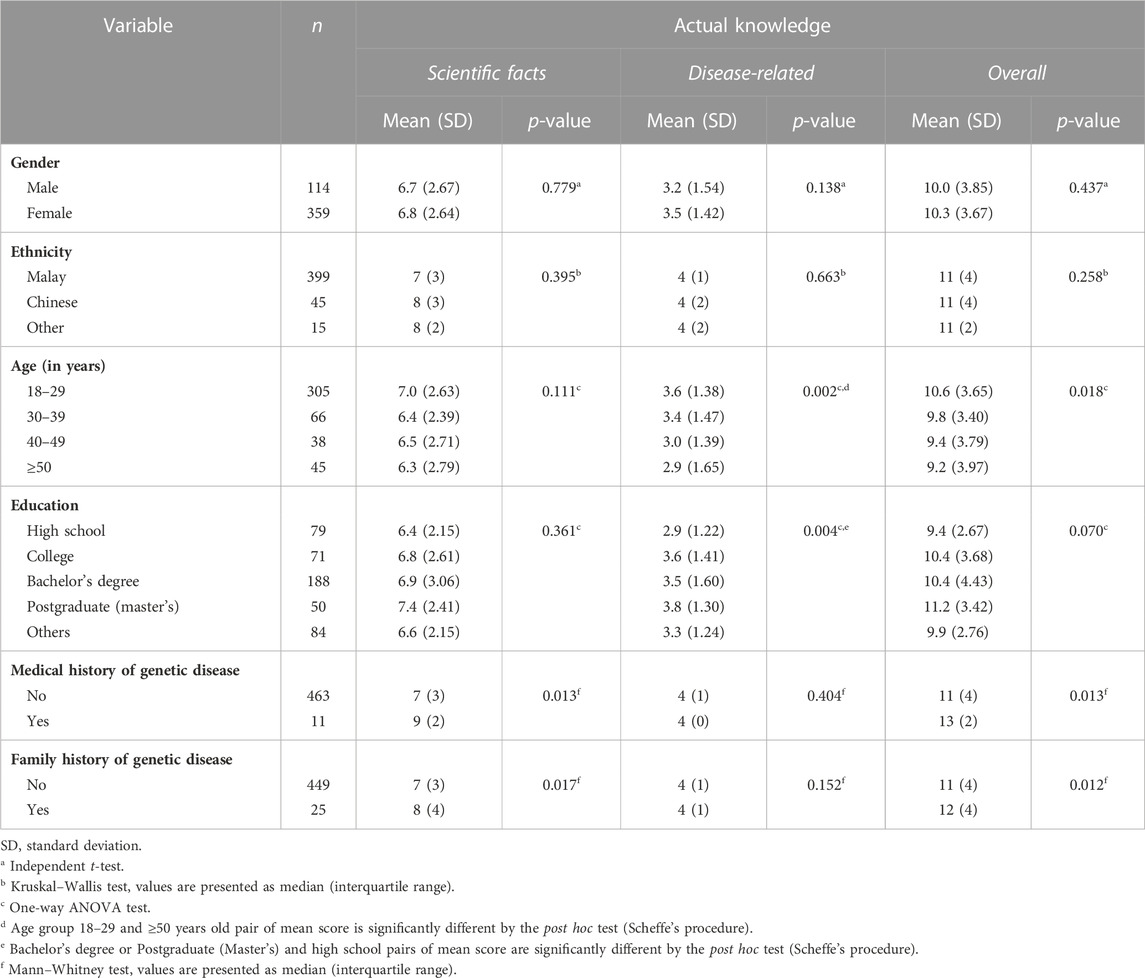
TABLE 3. Statistical analysis for the respective variables pertaining to actual knowledge of genetics.
Majority of the participants (n = 256, 54.0%) have adequate knowledge of genetics (Figure 2). The actual knowledge of genetics among the participants can be strongly associated with their educational level (p = <0.001) and having personal history of genetic diseases (p = 0.038) (Table 4).
3.3 Perceived genetic knowledge
In total, 60.9% of the participants reported to demonstrate some perceived knowledge (either little or sufficient) on genetics and genetic testing (Table 5). However, significantly less (p = 0.025) participants knew about the social consequences (54.0%) compared to the medical possibilities (65.5%) (Table 5). Out of all the medical possibilities of genetic testing, 80.1% participants were most familiar with the potential of testing in the early detection of specific diseases. On the social side, 61.3% of participants exhibited some knowledge on their rights to decline genetic testing. However, 50.4% of the participants showed no information on the rights of third parties over the results of a genetic test. The percentage response for each statement in Part 3 was compared to an American study (Haga et al., 2013) (Table 5). Our study reported a lower percentage mean response for “little” knowledge for both medical possibilities and social consequences (p = 0.023, Table 5). No significant difference was noted in overall mean scores with respect to gender, ethnicity, age group, education level, and personal medical and family history of genetic disease(s) (Table 6).
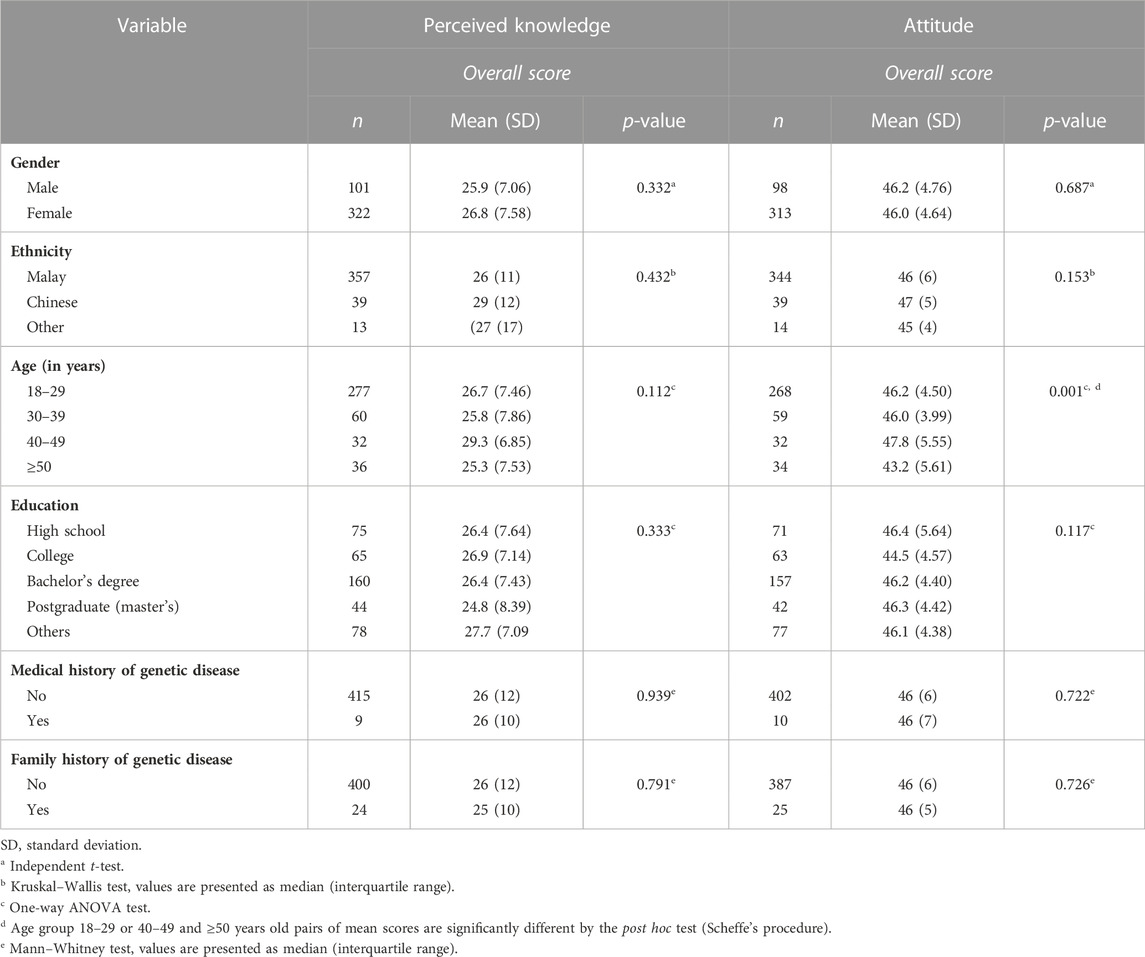
TABLE 6. p-value for the respective variables pertaining to questions on perceived knowledge of genetics and attitude toward genetic testing.
Analysis on each statement in Part 3 revealed majority of the participants (52.7%, Table 5) have little knowledge on the possibility of genetic knowledge to prevent or treat a disorder; participants with a family medical history of genetic disease know more than participants without a family history (p = 0.042). However, 49.5% (Table 5) of the participants do not know the consequences of genetic testing for taking out insurance; participants aged 40–49 years old reported more knowledge than participants aged 18–29 years old (p = 0.026).
3.4 Attitude toward genetic testing
Majority of the participants agreed more with statements associated with favorable attitudes than those with reserved attitudes (Table 7). Notably, participants agreed most that the development of DNA research is a positive progress in the medical field (82.8%, Table 7). In total, 80.3% of the participants believed that genetic tests could alter one’s future. When asked about informing their children about their genetic testing results for a specific disease, 63.8% of the participants would do so, while 69.4% would inform their siblings. Overall, the participants showed relatively good attitudes toward genetic testing, which is influenced by their age (p = 0.001, Table 6), where younger participants are open to the idea of genetic testing compared to older participants.
Notwithstanding the former finding, analysis on each statement in Part 4 revealed that the adolescents (18–29 years old) displayed higher concerns (p = 0.011) on the impact of genetic testing on their employment prospects than the older population (50 years old or above) and were more frightened by the idea of a genetic test (p = 0.041). It was also observed that the Chinese participants were more likely to want to know the hereditary nature of their disease compared to the Malay participants (p = 0.05). Individuals with a personal medical history of genetic disease also showed significantly higher curiosity than individuals with no personal history (p = 0.008). Participants with a master’s degree significantly agreed on the promising progress of DNA research than participants with other educational backgrounds (p = 0.006). Significant differences were also noted between participants with high school education, who were more reluctant to take a genetic test for an untreatable disease, and those with college education (p = 0.007) or a bachelor’s degree (p = 0.024) education. On that note, less proportion of participants with a family history of genetic disease, than those without, agreed to the statement that they would not want a genetic test for an untreatable disease (p = 0.037).
4 Discussion
Research in the area of genetics and genetic testing possesses vast potential in the field of personalized medicine. Genetic testing could provide early detection and prevention of diseases (Grosse and Khoury, 2006). However, utilization and optimization of such testing in clinical care settings only arrive upon certain factors including acceptance and accurate understanding (Kinney et al., 2010). Routine genetic testing is not conducted in Brunei Darussalam yet, and little is known locally about the level of knowledge, direction of attitudes, and their determining factors, surrounding genetic literacy and testing in this country. This study aimed to investigate the population’s actual and perceived knowledge on genetics and genetic testing, as well as attitudes, and the possible importance of these findings in relation to Brunei. The results from this study could contribute to the general picture of current knowledge on genetics and more importantly, facilitate national decisions on the use of genetic research and testing for its role in health and disease.
Assessment of actual knowledge of genetics on topics such as genes, chromosomes, and disease revealed an overall mean score of 69.4%. This score is lower than that of the study conducted in America that showed an overall average score of 83.6% (Haga et al., 2013), of which the questionnaire was adapted from. The observed disparity could be explained by the differences in socio-economy, culture, education curriculum, and health services provided including availability of genetic testing and counseling (Amin et al., 2012; Haga et al., 2013). Necessary genetic testing for patients in Brunei is performed overseas such as in Singapore. This part of the healthcare system could suggest a lack of national exposure to the realm of genetics and the remoteness of such a subject to the average public. In terms of education, the concept of genetics is introduced in year 11 (high school) in Brunei and only expanded if specific subjects, like Biology, are majored during further studies; otherwise, knowledge about genetics is dependent on the individual’s own interest. This is a contrast to the increased penetration of genetics into the American culture causing enhanced public familiarity (Bates, 2005). When compared to our neighboring countries, such as Malaysia, they also showed adequate knowledge of genetic testing (Chin and Tham, 2020), increasing the public familiarity of testing despite having similar culture. However, a German report states that public familiarity does not guarantee understanding. In addition, substantial information could also generate confusion and misconception (Berth et al., 2002).
Our study revealed that the younger participants demonstrated higher actual knowledge than the older participants, which is consistent with other published studies (Jallinoja and Aro, 1999; Calsbeek et al., 2007; Haga et al., 2013; Henneman et al., 2013). In addition to the knowledge from what they learn at school, the younger participants are also potentially exposed to information gathered from the internet, including those about genetic testing and its benefits (Covolo et al., 2015).Our results also established that a higher educational background of participants was associated with a higher level of genetic knowledge, which is also found in the previous report (Calsbeek et al., 2007; Chapman et al., 2019).Our study did not ask for the participants’ field of learning when they were in the higher education (university level). It would be interesting to see whether the higher level of genetic literacy findings in the public was related to their field of study, a finding that was found in a study conducted focusing on medical students in Indonesia (Rujito et al., 2020; Swandayani et al., 2021). Increased scientific research and, in the context of Brunei, the reformations in education and school systems (namely, bilingual education and SPN-21) through the years are likely to have played a part in the differences of knowledge exposed to the distinct generations. Moreover, the study reported that elderly people are also less likely to be influenced by the media (Calsbeek et al., 2007). It was observed that our study population exhibited more knowledge on disease-related concepts compared to scientific facts, which is consistent with the previous studies (Jallinoja and Aro, 1999; Calsbeek et al., 2007; Haga et al., 2013). A possible explanation for this finding is that people tend to retain longer memory on information that has more obvious effects on themselves than facts that seem irrelevant.
The level of perceived knowledge of the participants in this study is significantly lower than the participants in the American study (Haga et al., 2013) but higher than that of the Dutch study (Morren et al., 2007). It was hypothesized that one of the reasons for low perceived knowledge is that people are becoming more aware that their individual knowledge is only a minute fraction of what is known (Calsbeek et al., 2007). Moreover, the relationship between subjective evaluations of own knowledge and objective knowledge is suggested to be unspecified (Morren et al., 2007). In spite of this, motivation to find more genetic information would be inspired by perceived knowledge.
Knowledge assumes a vital position in the translation of genetic testing from the research bench to the healthcare venue. Higher degrees of knowledge ensure informed decision making (Haga et al., 2013). Inadequate information about genetics and genetic testing may be causing people to avoid taking a genetic test when necessary, leading to poorer health, reduced quality of life, and increased medical costs when an easily preventable disease requires later treatment (Morren et al., 2007). Education on genetics and genetic testing could be carried out by clinicians, for example, general practitioners (GP), which is the preferred source of genetic information (Morren et al., 2007). However, it was reported that GPs and even clinical geneticists expressed a lack of confidence in their genetic expertise and, consequently, their ability to provide such information to patients (Kampourakis, 2017). Preparation of genetic testing in Brunei, thus, not only takes into account public readiness but also proper training or qualification of healthcare professionals should also be prioritized, which include the availability of a qualified genetic counselor (Matusin, 2020). Such training for healthcare providers must see meticulous tailoring in the knowledge of and skills to perform the genetic test itself, and understanding of the ethical issues on the access of the information to be provided for the general population.
Participants with a family medical history of genetic disease displayed a higher interest in genetic testing, even for an untreatable disease, than participants without a family history. Research has found conflicting associations between a familial history and interest in breast cancer genetic testing, reporting positive (Kash and Dabney, 2001), negative (Andrykowski et al., 1997), and no associations (Donovan and Tucker, 2000) between the two. However, high interest in genetic testing is not synonymous with true demand for testing (Bruno et al., 2004) as it could stem from interest in modern laboratory procedures, inappropriate knowledge of genetic testing, or curiosity-driven behavior (Bottorff et al., 2002).
This study was limited by the missing data across all parts of the questionnaire. For data collection conducted in public areas, allowing face-to-face interaction with participants, it was observed that not all participants displayed interest on the topic of genetics despite attempting the questionnaire. This lack of motivation makes it difficult to assess the true knowledge level of participants. In addition to the lack of interest, missing data could be attributed to inconvenient timing or difficulty of the questionnaire. Another limitation is the answer choices for the actual knowledge of genetics. A correct response for this section could be merely coincidental or guess work. Further use of this survey instrument could include an “I do not know” option revealing the true lack of knowledge or lack of confidence in one’s knowledge. The questionnaires for this study were also made available through social media, which might help account for the population who do not go to the visited frequented areas, and added to the strength of this study, which is the large sample size. Participants from the Chinese and other ethnic groups only make up about 10% of the sample size and males around 20%, which is not representative of the Bruneian population. Further research could ensure appropriate distribution of the study across ethnicity and gender.
In conclusion, the full potential of genetics and genetic testing in health and disease is currently not channeled to the world population. This bottleneck phenomenon could be due to the variation of knowledge and attitudes held by people surrounding testing, owing to the many influences such as media, service provision agencies, and scientific publication. Thus, assessment of public knowledge and attitudes of the consumers of genetic testing is a great stepping stone toward tailoring the nation’s lens so as to reap the benefits of this genetics era.
Data availability statement
The original contributions presented in the study are included in the article/Supplementary Material; further inquiries can be directed to the corresponding author.
Ethics statement
The studies involving human participants were reviewed and approved by the PAPRSB Institute of Health Sciences (IHS) Research and Ethics Committee (IHSREC) of Universiti Brunei Darussalam (UBD). The patients/participants provided their written informed consent to participate in this study.
Author contributions
MH conceptualized and designed the original study. HJ contributed to the study design, collected data, performed the statistical analysis, and wrote the first draft of the manuscript. HJ, SM, and AM wrote sections of the manuscript. SM, AM, and MA critically revised the manuscript. SM finalized the manuscript. All authors contributed to editing of the manuscript and approved the submitted version.
Acknowledgments
The authors would like to thank the public of Brunei Darussalam who participated in the study.
Conflict of interest
The authors declare that the research was conducted in the absence of any commercial or financial relationships that could be construed as a potential conflict of interest.
Publisher’s note
All claims expressed in this article are solely those of the authors and do not necessarily represent those of their affiliated organizations, or those of the publisher, the editors, and the reviewers. Any product that may be evaluated in this article, or claim that may be made by its manufacturer, is not guaranteed or endorsed by the publisher.
References
Amin, T. T., Al-Wadaani, H. A., Al-Quaimi, M. M., Aldairi, N. A., Alkhateeb, J. M., and Al-Jaafari, A. A. L. (2012). Saudi women’s interest in breast cancer gene testing: Possible influence of awareness, perceived risk and sociodemographic factors. Asian Pac. J. Cancer Prev. 13, 3879–3887. doi:10.7314/apjcp.2012.13.8.3879
Andrykowski, M. A., Lightner, R., Studts, J. L., and Munn, R. K. (1997). Hereditary cancer risk notification and testing: How interested is the general population? J. Clin. Oncol. 15, 2139–2148. doi:10.1200/JCO.1997.15.5.2139
Bates, B. R. (2005). Public culture and public understanding of genetics: A focus group study. Public Underst. Sci. 14, 47–65. doi:10.1177/0963662505048409
Berth, H., Balck, F., and Dinkel, A. (2002). Attitudes toward genetic testing in patients at risk for HNPCC/FAP and the German population. Genet. Test. 6, 273–280. doi:10.1089/10906570260471804
Boerwinkel, D. J., Yarden, A., and Waarlo, A. J. (2017). Reaching a consensus on the definition of genetic literacy that is required from a twenty-first-century citizen. Sci. Educ. 26, 1087–1114. doi:10.1007/s11191-017-9934-y
Bottorff, J. L., Ratner, P. A., Balneaves, L. G., Richardson, C. G., McCullum, M., Hack, T., et al. (2002). Women’s interest in genetic testing for breast cancer risk: The influence of sociodemographics and knowledge. Cancer Epidemiol. Biomarkers Prev. 11, 89–95.
Bruno, M., Tommasi, S., Stea, B., Quaranta, M., Schittulli, F., Mastropasqua, A., et al. (2004). Awareness of breast cancer genetics and interest in predictive genetic testing: A survey of a southern Italian population. Ann. Oncol. 15, i48–I54. doi:10.1093/annonc/mdh658
Calsbeek, H., Morren, M., Bensing, J., and Rijken, M. (2007). Knowledge and attitudes towards genetic testing: A two year follow-up study in patients with asthma, diabetes mellitus and cardiovascular disease. J. Genet. Couns. 16, 493–504. doi:10.1007/s10897-006-9085-9
Cappelli, M., Surh, L., Humphreys, L., Verma, S., Logan, D., Hunter, A., et al. (1999). Psychological and social determinants of women’s decisions to undergo genetic counseling and testing for breast cancer. Clin. Genet. 55, 419–430. doi:10.1034/j.1399-0004.1999.550605.x
Caulfield, T., and Condit, C. (2012). Science and the sources of hype. Public Health Genomics 15, 209–217. doi:10.1159/000336533
Chapman, R., Likhanov, M., Selita, F., Zakharov, I., Smith-Woolley, E., and Kovas, Y. (2019). New literacy challenge for the twenty-first century: Genetic knowledge is poor even among well educated. J. Community Genet. 10, 73–84. doi:10.1007/s12687-018-0363-7
Chin, J. J., and Tham, H. W. (2020). Knowledge, awareness, and perception of genetic testing for hereditary disorders among Malaysians in klang valley. Front. Genet. 11, 512582. doi:10.3389/fgene.2020.512582
Control U for IC (2020). Globocan 2020: New global cancer data. https://www.uicc.org/news/globocan-2020-new-global-cancer-data (accessed June 24, 2021).
Covolo, L., Rubinelli, S., Ceretti, E., and Gelatti, U. (2015). Internet-based direct-to-consumer genetic testing: A systematic review. J. Med. Internet Res. 17, e279. Epub ahead of print 2015. doi:10.2196/jmir.4378
Donovan, K. A., and Tucker, D. C. (2000). Knowledge about genetic risk for breast cancer and perceptions of genetic testing in a sociodemographically diverse sample. J. Behav. Med. 23, 15–36. doi:10.1023/a:1005416203239
Goodwin, S., McPherson, J. D., and McCombie, W. R. (2016). Coming of age: Ten years of next-generation sequencing technologies. Nat. Rev. Genet. 17, 333–351. doi:10.1038/nrg.2016.49
Grosse, S. D., and Khoury, M. J. (2006). What is the clinical utility of genetic testing? Genet. Med. 8, 448–450. doi:10.1097/01.gim.0000227935.26763.c6
Haga, S. B., Barry, W. T., Mills, R., Ginsburg, G. S., Svetkey, L., Sullivan, J., et al. (2013). Public knowledge of and attitudes toward genetics and genetic testing. Genet. Test. Mol. Biomarkers 17, 327–335. doi:10.1089/gtmb.2012.0350
Henneman, L., Vermeulen, E., Van El, C. G., Claassen, L., Timmermans, D. R. M., and Cornel, M. C. (2013). Public attitudes towards genetic testing revisited: Comparing opinions between 2002 and 2010. Eur. J. Hum. Genet. 21, 793–799. doi:10.1038/ejhg.2012.271
Hietala, M., Hakonen, A., Aro, A. R., Niemelä, P., Peltonen, L., and Aula, P. (1995). Attitudes toward genetic testing among the general population and relatives of patients with a severe genetic disease: A survey from Finland. Am. J. Hum. Genet. 56, 1493–1500.
Jallinoja, P., and Aro, A. R. (1999). Knowledge about genes and heredity among Finns. New Genet. Soc. 18, 101–110. doi:10.1080/14636779908656892
JPKE) D of EP Brunei, D. (2018). Darussalam key indicators (BDKI). Available at: http://www.depd.gov.bn/DEPD.Documents.Library/DOS/BDKI/BDKI_2018.pdf (accessed 21 March 2019).
Kampourakis, K. (2017). Public understanding of genetic testing and obstacles to genetics literacy. Elsevier Ltd. Epub ahead of print. doi:10.1016/B978-0-12-802971-8.00027-4
Kash, K. M., and Dabney, M. K. (2001). Psychological aspects of cancer screening in high-risk populations. Med. Pediatr. Oncol. 36, 519–524. doi:10.1002/mpo.1124
Kinney, A. Y., Gammon, A., Coxworth, J., Simonsen, S. E., and Arce-Laretta, M. (2010). Exploring attitudes, beliefs, and communication preferences of Latino community members regarding BRCA1/2 mutation testing and preventive strategies. Genet. Med. 12, 105–115. doi:10.1097/GIM.0b013e3181c9af2d
Lea, D. H., Kaphingst, K. A., Bowen, D., Lipkus, I., and Hadley, D. W. (2011). Communicating genetic and genomic information: Health literacy and numeracy considerations. Public Health Genomics 14, 279–289. doi:10.1159/000294191
Matusin, S. N. I. (2020). Genetic variation profiling of inherited breast cancer genes in Brunei breast cancer patients. Negara Brunei Darussalam: Universiti Brunei Darussalam.
Miki, Y., Swensen, J., Shattuck-Eidens, D., Futreal, P. A., Harshman, K., Tavtigian, S., et al. (1994). Candidate ovarian and breast susceptibility gene for the cancer. Science 266 (5182), 66–71. doi:10.1126/science.7545954
Morren, M., Rijken, M., Baanders, A. N., and Bensing, J. (2007). Perceived genetic knowledge, attitudes towards genetic testing, and the relationship between these among patients with a chronic disease. Patient Educ. Couns. 65, 197–204. doi:10.1016/j.pec.2006.07.005
Raosoft (2021). Sample size calculator. Available at: http://www.raosoft.com/samplesize.html (accessed June 24, 2021).
Rujito, L., Nandhika, T., Lestari, D. W. D., Ferine, M., and Muhaimin, A. (2020). Genetic literacy levels and genetic screening attitudes on medical students in Indonesia: A national survey. Malays. J. Public Heal Med. 20, 1–8. doi:10.37268/mjphm/vol.20/no.3/art.407
Swandayani, Y. M., Cayami, F. K., Winarni, T. I., and Utari, A. (2021). Familiarity and genetic literacy among medical students in Indonesia. BMC Med. Educ. 21, 524–610. doi:10.1186/s12909-021-02946-8
Vermeulen, E., Henneman, L., Van El, C. G., and Cornel, M. C. (2013). Public attitudes towards preventive genomics and personal interest in genetic testing to prevent disease: A survey study. Eur. J. Public Health 24, 768–775. doi:10.1093/eurpub/ckt143
Keywords: genetics, genetic testing, public, knowledge, attitudes, perception
Citation: Jaya H, Idayu Matusin SN, Mustapa A, Abdullah MS and Haji Abdul Hamid MRW (2023) Public knowledge of and attitudes toward genetics and genetic testing in Brunei Darussalam. Front. Genet. 14:1181240. doi: 10.3389/fgene.2023.1181240
Received: 07 March 2023; Accepted: 05 April 2023;
Published: 24 April 2023.
Edited by:
Raphael Zozimus Sangeda, Muhimbili University of Health and Allied Sciences, TanzaniaReviewed by:
Jan Domaradzki, Poznan University of Medical Sciences, PolandCristina Skrypnyk, Arabian Gulf University, Bahrain
Copyright © 2023 Jaya, Idayu Matusin, Mustapa, Abdullah and Haji Abdul Hamid. This is an open-access article distributed under the terms of the Creative Commons Attribution License (CC BY). The use, distribution or reproduction in other forums is permitted, provided the original author(s) and the copyright owner(s) are credited and that the original publication in this journal is cited, in accordance with accepted academic practice. No use, distribution or reproduction is permitted which does not comply with these terms.
*Correspondence: Mas Rina Wati Haji Abdul Hamid, cmluYS5oYW1pZEB1YmQuZWR1LmJu
†Present addresses: Hazreana Jaya, Pengiran Anak Puteri Rashidah Sa’adatul Bolkiah (PAPRSB) Institute of Health Sciences, Universiti Brunei Darussalam, Gadong, Brunei, Siti Nur Idayu Matusin, Pengiran Anak Puteri Rashidah Sa’adatul Bolkiah (PAPRSB) Institute of Health Sciences, Universiti Brunei Darussalam, Gadong, Brunei
‡These authors have contributed equally to this work and share first authorship
 Hazreana Jaya1†‡
Hazreana Jaya1†‡ Siti Nur Idayu Matusin
Siti Nur Idayu Matusin Mas Rina Wati Haji Abdul Hamid
Mas Rina Wati Haji Abdul Hamid